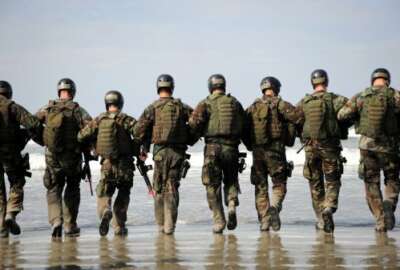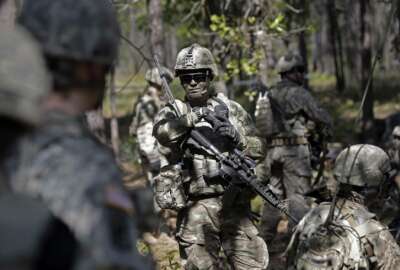
Is DoD’s top personnel and readiness job doomed?
The defense undersecretary for personnel and readiness position has been largely vacant for the past five years. Is it too big for one person?
Best listening experience is on Chrome, Firefox or Safari. Subscribe to Federal Drive’s daily audio interviews on Apple Podcasts or PodcastOne.
The top office managing some of the Defense Department’s most important programs like military education, health and human resources suffered its most recent casualty this week with the retirement of James Stewart.
Stewart was performing the duties of defense undersecretary for personnel and readiness. While military experts agree Stewart did a fine job in the position, the role has suffered a beleaguered and ignored existence in the recent past considering the impact of its portfolio.
Air Force Undersecretary Matt Donovan will be taking over the acting role of defense undersecretary for personnel and readiness.
Since March 2015, only one person has been nominated by the president and confirmed by the Senate to hold the position. That was Robert Wilkie, who did an eight month stint in the role until he was tapped to be the Department of Veterans Affairs secretary.
“The office has been in a state of leadership turmoil almost continuously since David Chu departed in January 2009—nearly 11 years now,” Todd Harrison, senior fellow at the Center for Strategic and International Studies told Federal News Network.
Outside of Wilkie, the job has been filled by people working in the acting or “performing the duties” capacity, leaving those familiar with the position worried about the state of the office and others questioning if it should even exist at all.
“When you look at all the issues that that secretariat has to deal with, it’s probably one of the most difficult jobs in the Department of Defense,” Arnold Punaro, CEO of The Punaro Group and member of the Defense Business Board. “It’s all the social issues like the transgender issue. It’s all the medical and health affairs issues when you are consolidating under the Defense Health Agency. It’s the readiness of the force under former Defense Secretary Jim Mattis’ defense strategy. It’s looking at how to increase the lethality of the force, civilian personnel, the commissaries, the DoD dependent schools.”
Personnel losing key advocate
Because of the weight of the job, former defense assistant secretary for manpower and reserve affairs and managing partner at Blue Rose Consulting Group Todd A. Weiler says the vacancies have been damaging to military personnel.
“Without a personnel and readiness undersecretary or a strong manpower and reserve affairs assistant secretary, then there is no advocacy voice for the men, women and families serving our nation, in and out of uniform,” Weiler told Federal News Network. “What I hear is that morale is at its lowest perhaps since the Vietnam era.”
Related Stories

Lack of leadership in DoD’s personnel and readiness office could be detrimental, analysts say

Military service chiefs poised to gain more acquisition power
“The lack of interested and qualified candidates putting their name forward for confirmation as personnel and readiness undersecretary is absolutely a problem. And quite telling of the challenges within that office,” Mackenzie Eaglen, resident fellow at the American Enterprise Institute, told Federal News Network. “Reorganizing the office would be the kind of bold move a Secretary of Defense could make to signal real change and commitment to a new direction. But few are willing to go this far. If this president wins reelection and the position sits empty or acting in 2020, it will be time to do triage and put this office on life support.”
Weiler went as far as to suggest it is time to push some responsibilities of the secretariat down to the assistant secretaries serving under it.
“Under the current DoD political structure, too much power is concentrated in a few undersecretaries,” he said. I believe the time has come to push much of that back down to the assistant secretaries. There is far too much in the portfolio of a personnel and readiness undersecretary to be effective.”
The undersecretary oversees three assistant secretary positions.
Harrison and Eaglen made a similar suggestion back in 2017. Harrison noted that the 2021 budget would be an opportune time for Defense Secretary Mark Esper to make changes to the office as part of his defense-wide review.
Punaro, on the other hand, thinks differently.
“It’s always good to have a person confirmed,” Punaro said. “But acting and performing the duties roles are really a distinction without a difference because it’s so limited in terms of what your constraints are.”
Punaro stressed that not many people are willing to take on such a big job, and DoD has been lucky in the past to have good people in the acting position.
Despite that challenge, he doesn’t think the position should go away.
“By breaking the position down into two or three assistant secretaries you just increased the direct reports to the deputy secretary of defense, who is already overwhelmed and busy,” Punaro said. “I don’t see how organizationally you could break it up without creating another management problem within the Pentagon. How do you integrate all that?”
Copyright © 2024 Federal News Network. All rights reserved. This website is not intended for users located within the European Economic Area.
Scott Maucione is a defense reporter for Federal News Network and reports on human capital, workforce and the Defense Department at-large.
Follow @smaucioneWFED




